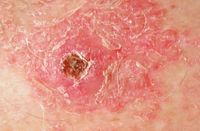- Acne
- Actinic Keratosis
- Aesthetics
- Alopecia
- Atopic Dermatitis
- Buy-and-Bill
- COVID-19
- Case-Based Roundtable
- Chronic Hand Eczema
- Chronic Spontaneous Urticaria
- Drug Watch
- Eczema
- General Dermatology
- Hidradenitis Suppurativa
- Melasma
- NP and PA
- Pediatric Dermatology
- Pigmentary Disorders
- Practice Management
- Precision Medicine and Biologics
- Prurigo Nodularis
- Psoriasis
- Psoriatic Arthritis
- Rare Disease
- Rosacea
- Skin Cancer
- Vitiligo
- Wound Care
Article
Testing identifies key culprits in ACD
Miami — Bacitracin has been labeled a top cause of allergic contact dermatitis (ACD) in children. Notably, it is an ingredient in Neosporin (Pfizer) and a staple in first aid kits in schools, summer camps and just about every other child-centered environment. Yet private practitioners do not routinely test for this allergen.

"This is because the most commonly used testing modality is the commercially available Thin-layer Rapid Use Epicutaneous (T.R.U.E.) test (Allerderm Laboratories). The T.R.U.E. test comprises 23 allergens, and bacitracin is not one of them," says Sharon E. Jacob, M.D., assistant professor of clinical dermatology at the University of Miami and director of the U.M. Contact Dermatitis Clinic. "The probability of detecting a reaction with the T.R.U.E. test is about 25 percent."
This, Dr. Jacob says, is among the many reasons why dermatologists should have access to more comprehensive patch testing for both the pediatric and adult populations. This may be easier said than done, she says, as there are 14,950 members of the American Academy of Dermatology and only roughly 450 members of the American Contact Dermatitis Society (ACDS).
Dr. Jacob reported on allergic contact dermatitis (ACD) in the pediatric population at the Masters of Pediatrics meeting here.

During an ACDS mentorship program with Dr. David E. Cohen at New York University (NYU), Dr. Jacob began researching allergic contact dermatitis in the pediatric population. Between 1984 and 2004, there were 10 landmark journal articles; seven were from Europe, one from Brazil and the other two from the United States. The historic studies were cross referenced and a top allergen list was compiled. Based on this allergen list and the NYU experience, a pediatric series was devised of the top 40 most relevant allergens among the pediatric population.
Allergic contact dermatitis ACD, Dr. Jacob points out, represents about 20 percent of exogenous dermatitis. The remainder is considered irritant-based contact dermatitis and contact urticaria. ACD can be acute, subacute or chronic, and most commonly involves the hands and face.
"Oftentimes there can be an ectopic reaction, for example, eyelid dermatitis might turn out to be nail polish-induced. Once they rub their eye, contact is made," she says. Nail polish often contains tosylamide formaldehyde resin, which remains high on the list of common contact allergens among children because of the number of teenage girls with this exposure. Sensitization usually takes about 21 days.
"The antigen has to penetrate the epidermis, and covalently bond to keratinocytes. The antigen is then recognized by an Antigen Presenting Cell (APC), which carries the antigen to lymph nodes where T-cell clonal expansion occurs," Dr. Jacob explains.
While the T.R.U.E. test is an effective screening tool in the private practice setting, Dr. Jacob utilizes the comprehensive customized approach based on a patient's history.
"I'll talk to the patient or the patient's parent about exposures, and follow the clues presented by the location of the dermatitis," she says. "Then I select the patch test series I feel will be most relevant based on the suspected allergens."
A patch challenge test takes about 48 to 96 hours. The mechanism of action is re-recognition of the offending antigen by memory T-cells followed by secretion of the cytokines IL-2 and IFN-y, Dr. Jacob says.
Newsletter
Like what you’re reading? Subscribe to Dermatology Times for weekly updates on therapies, innovations, and real-world practice tips.
















